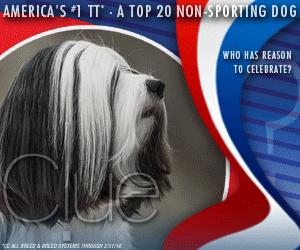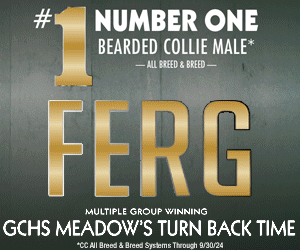Quality: You Don’t Get Far Without It
158 – May, 2016
by William Given
 My wife and I were recently sitting ringside watching the group competition at a large show held in Denver, Colorado. Nearby sat a disgruntled exhibitor who was complaining to one of her friends, “…Best In Show and the Group placements always go to the heavy hitters.” And, she explained that heavy hitters meant those who owned large kennels of dogs, owners who were very wealthy and/or well-known professional handlers. During my many years in dogs, I have learned that success depends not on the size of the kennel, the wealth of an owner, or the skills of the professional handler, but rather on the quality of the dogs being exhibited. A thorough review of the history of most breeds will show that many of the many successful dogs have come from very small kennels, owners who do not enjoy great wealth or have been owner-handled. Anyone who attends a good many shows and examines the placings may easily prove to himself or herself that this is the case. The fact that the names of certain owners appear more often on the lists of awards is natural, for those owners show more often and much more consistently than most of their competitors.
My wife and I were recently sitting ringside watching the group competition at a large show held in Denver, Colorado. Nearby sat a disgruntled exhibitor who was complaining to one of her friends, “…Best In Show and the Group placements always go to the heavy hitters.” And, she explained that heavy hitters meant those who owned large kennels of dogs, owners who were very wealthy and/or well-known professional handlers. During my many years in dogs, I have learned that success depends not on the size of the kennel, the wealth of an owner, or the skills of the professional handler, but rather on the quality of the dogs being exhibited. A thorough review of the history of most breeds will show that many of the many successful dogs have come from very small kennels, owners who do not enjoy great wealth or have been owner-handled. Anyone who attends a good many shows and examines the placings may easily prove to himself or herself that this is the case. The fact that the names of certain owners appear more often on the lists of awards is natural, for those owners show more often and much more consistently than most of their competitors.
The novice must realize that show merit represents the combination of inherited structural quality plus early socialization, training, conditioning and handling. This is generally gleaned through experience and knowledge, which newcomers to the game so often lack and must focus on acquiring. The novice who wants to enjoy the excitement of success through showing a dog into the top 20 of their breed should bring with them a great deal of enthusiasm and balanced judgement. The assumed cynicism of the exhibitor who does not always win and accuses judges of favoring wealthy owners or better-known professional handlers is as unhelpful to himself as it is negative to everyone else sitting ringside.

ANOTHER UNFOUNDED STATEMENT
Another equally unfounded statement I overheard was that, “only those traits which are visible in the parents can be transmitted to their offspring.” Were it true that only the characteristics present in the sire and dam can be transmitted to their offspring and that all parental traits are passed on in their entirety there would, of course, be little point at all in attempting to improve any breed, or any animal for that matter. Fortunately, for us, this is certainly not the case. It would, however, be difficult to formulate a statement containing a greater fallacy than the one quoted. To begin with, it is not the visible properties of an individual dog which are inherited by the progeny but rather certain factors, called genes, which will cause particular characteristics to develop under normal conditions. The traits, which the inheritance of those genes will produce, may or may not be displayed by one or both of the parents. The qualities likely to be shown by a dog must be judged, not only by the visual strength of the qualities of the sire and dam but the genetic constitution, that is, by the genes which pass to the offspring. This is the basic principle on which all breedings should be planned and conducted.
Click here to read the complete article148 – May, 2016
Short URL: https://caninechronicle.com/?p=103574
Comments are closed











